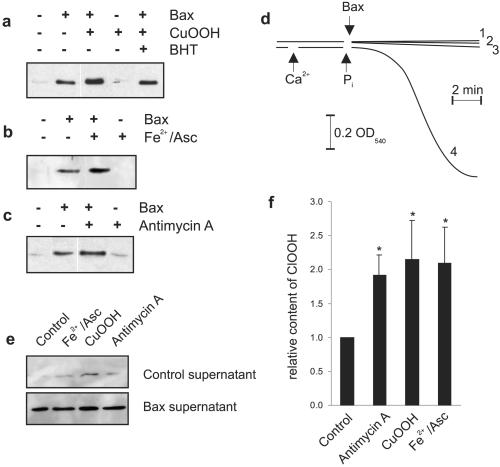Figure 2.
Oxidative stress mobilizes a unique pool of cytochrome c that involves peroxidation of cardiolipin. (a–c) Mitochondria (1 mg/ml) were incubated as described in Materials and Methods and treated with different ROS-generating systems. After a 5-min stabilization period, Bax and inducers of ROS were added. After 8 min, samples were centrifuged, and the supernatants were separated by SDS/PAGE and Western-blotted for the presence of cytochrome c as described in Materials and Methods. The concentrations of the different reagents are as follows: cumene hydroperoxide (250 μM), butylated hydroxytoluene (5 μM), Fe(II)SO4 (60 μM)/ascorbate (500 μM), antimycin A (5 μg/ml) + ATP (1 mM). (d) Changes in mitochondrial (0.5 mg/ml) volume were evaluated in the presence of the different ROS-generating systems as follows: trace 1, cumene hydroperoxide; trace 2, Fe2+/Asc; trace 3, antimycin A; trace 4, shows a positive control induced by 150 nmol of Ca2+ per mg of protein and 5 mM Pi. (e) Duplicate samples (a–c) were separated by SDS/PAGE and Western-blotted for the presence of AK-2. (f) Mitochondria were incubated as described for a–c, and lipids were extracted after 13 min as presented in Materials and Methods. An aliquot was subjected to HPLC analysis, and quantitative analysis of the cardiolipin hydroperoxide content obtained from three independent experiments is presented. Data are expressed as means ± SD. *, significantly different from control mitochondria. BHT, butylated hydroxytoluene; CuOOH, cumene hydroperoxide.

